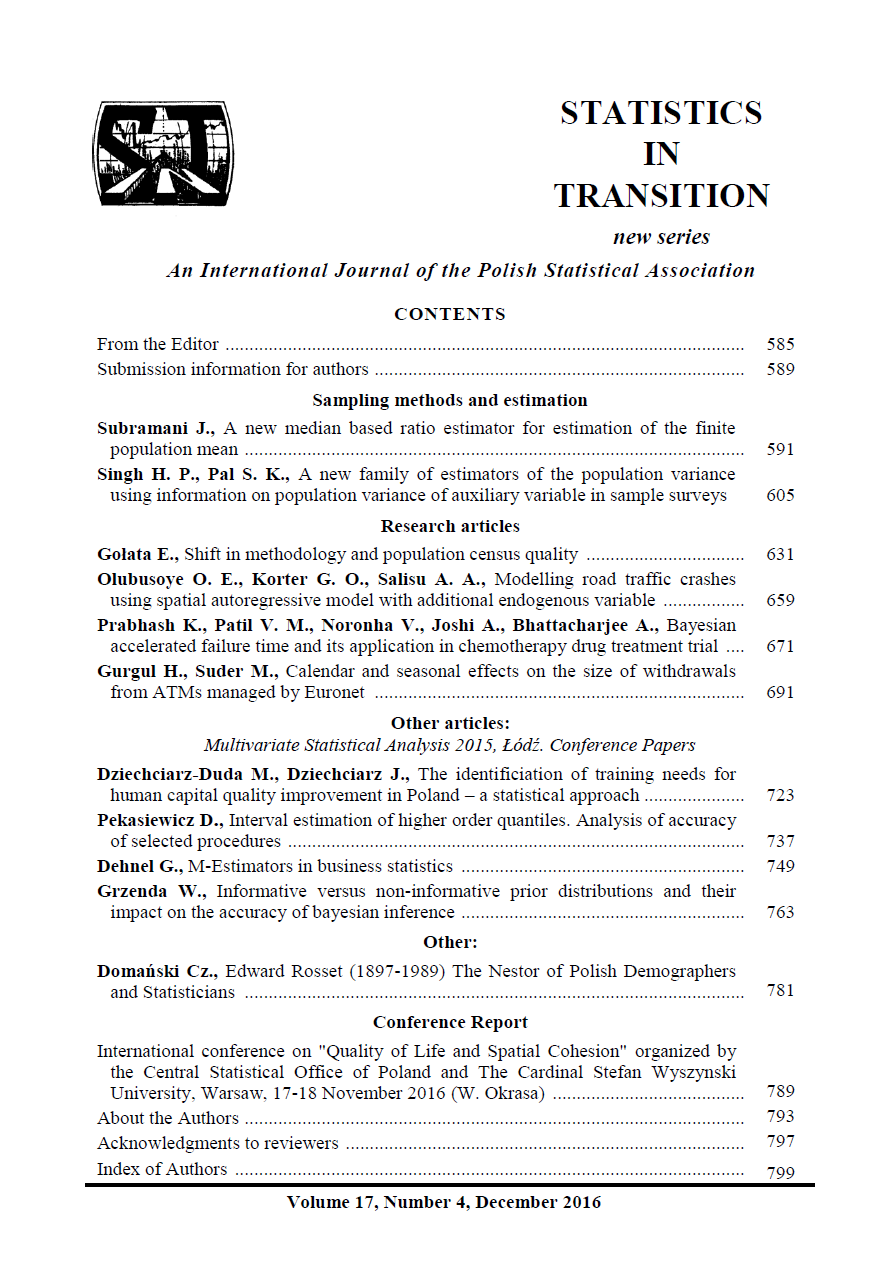ARTICLE
ABSTRACT
Recent years have seen a dynamic development in statistical methods for analysing data contaminated with outliers. One of the more important techniques that can deal with outlying observations is robust regression, which represents four decades of research. Until recently the implementation of robust regression methods, such as M-estimation or MM-estimation, was limited owing to their iterative nature. With advances in computing power and the growing availability of statistical packages, such as R and SAS, Stata, the applicability of robust regression methods has increased considerably.The aim of the study is to evaluate one of these methods, namely M-estimation, using data from a survey of small and medium-sized businesses. The comparison involves nine M-estimators, each based on a different weighting function. The results and conclusions are formulated on the basis of empirical data from the DG-1 business survey.
KEYWORDS
robust regression, M-estimation, business statistics, outliers
REFERENCES
ALMA, Ö. G., (2011). Comparison of Robust Regression Methods in Linear Regression, [in:] Int. J. Contemp. Math. Sciences, Vol. 6, No. 9, pp. 409–421.
BANAŚ, M., LIGAS, M., (2014). Empirical tests of performance of some M estimators, Geodesy And Cartography, Vol. 63, No. 2, pp. 127–146.
CHEN, C., (2007). Robust Regression and Outlier Detection with the ROBUSTREG Procedure, SUGI, http://www2.sas.com/proceedings/sugi27/ pp.265–27.pdf.
CHEN, C., YIN, G., (2002). Computing the Efficiency and Tuning Constants for M-Estimation, Proceedings of the 2002 Joint Statistical Meetings, 478–482.
COX, B. G., BINDER, A., CHINNAPPA, N. B., CHRISTIANSON, A.,COLLEDGE, M. J., KOTT, P. S., (1995). Business Survey Methods, John Wiley and Sons.
FAIR, R. C. (1974). On the robust estimation of econometric models, Ann. Econ. Social Measurement, 3, pp. 667–678.
HAMPEL, F. R., RONCHETTI, E. M., ROUSSEEUW, P. J. STAHEL, W. A.,(1986). Robust Statistics: The Approach Based on Influence Functions, Wiley, New York.
HOLLAND, P., WELSCH, R., (1977). Robust Regression Using Interactively Reweighted Least-Squares, Commun. Statist. Theor. Meth., 6, 813–827.
HUBER, P. H., (1964). Robust estimation of a location parameter, The Annals of Mathematical Statistics, 35, pp. 7–101.
HUBER, P. H., (1981). Robust Statistics, New York: John Wiley and Sons.
RIPLEY, B. D., (2004). Robust Statistics, M.Sc. in Applied Statistics MT2004, 1992-2004, https://www.stats.ox.ac.uk/pub/StatMeth/Robust.pdf.
ROUSSEEUW, P. J., LEROY, A. M., (1987). Robust Regression and Outlier Detection. Wiley-Interscience, New York.
SAS INSTITUTE INC., (2014). SAS/STAT® 13.2 User’s Guide. The Robustreg Procedure Cary, NC: SAS Institute Inc.
STROMBERG, A. J., (1993). Computation of high breakdown nonlinear regression parameters, [in:] Journal of the American Statistical Association, 88 (421).
TRZPIOT, G., (2013). Wybrane statystyki odporne [Selected resistant statistics], [in:] Studia Ekonomiczne, No. 152, pp. 162–173, Uniwersytet Ekonomiczny w Katowicach.
VENABLES, W. N., RIPLEY, B. D., (2002). Modern Applied Statistics with S-PLUS. Springer-Verlag.
VERARDI, V., CROUX, C., (2009). Robust regression in Stata, [in:] The Stata Journal, 9, No. 3, pp. 439–453
